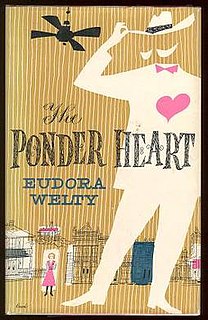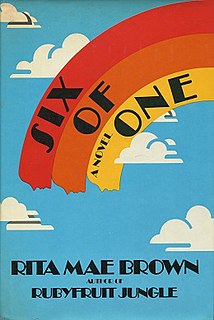
Eudora Alice Welty was an American short story writer, novelist and photographer, who wrote about the American South. Her novel The Optimist's Daughter won the Pulitzer Prize in 1973. Welty received numerous awards, including the Presidential Medal of Freedom and the Order of the South. She was the first living author to have her works published by the Library of America. Her house in Jackson, Mississippi, has been designated as a National Historic Landmark and is open to the public as a house museum.

Byron De La Beckwith Jr. was an American white supremacist and Klansman from Greenwood, Mississippi, who assassinated the civil rights leader Medgar Evers on June 12, 1963. Two trials in 1964 on that charge, with all-white Mississippi juries, resulted in hung juries. In 1994, he was tried by the state in a new trial based on new evidence, convicted of the murder by a mixed jury, and sentenced to life in prison.

The Awakening is a novel by Kate Chopin, first published in 1899. Set in New Orleans and on the Louisiana Gulf coast at the end of the 19th century, the plot centers on Edna Pontellier and her struggle between her increasingly unorthodox views on femininity and motherhood with the prevailing social attitudes of the turn-of-the-century American South. It is one of the earliest American novels that focuses on women's issues without condescension. It is also widely seen as a landmark work of early feminism, generating a mixed reaction from contemporary readers and critics.
Anne Tyler is an American novelist, short story writer, and literary critic. She has published twenty-three novels, including Dinner at the Homesick Restaurant (1982), The Accidental Tourist (1985), and Breathing Lessons (1988). All three were finalists for the Pulitzer Prize for Fiction, and Breathing Lessons won the prize in 1989. She has also won the Janet Heidinger Kafka Prize, the Ambassador Book Award, and the National Book Critics Circle Award. In 2012 she was awarded The Sunday Times Award for Literary Excellence. Tyler's twentieth novel, A Spool of Blue Thread, was shortlisted for the Man Booker Prize in 2015, and Redhead By the Side of the Road was longlisted for the same award in 2020. She is recognized for her fully developed characters, her "brilliantly imagined and absolutely accurate detail", her "rigorous and artful style", and her "astute and open language."

Hateship, Friendship, Courtship, Loveship, Marriage is a book of short stories by Alice Munro, published by McClelland and Stewart in 2001.

"The Goose Girl" is a German fairy tale collected by the Brothers Grimm and first published in Grimm's Fairy Tales in 1815. It is of Aarne-Thompson type 533.

A Curtain of Green was the first collection of short stories written by Eudora Welty. In these stories, Welty looks at the state of Mississippi through the eyes of its inhabitants, the common people, both black and white, and presents a realistic view of the racial relations that existed at the time. Welty, though, looks past race, not overtly focusing on the subject, and sees Mississippi as what it is. The stories subtly combine myth and reality to create portraits of odd, but undeniable, beauty. One of the finest pieces in the collection is titled "A Worn Path." Welty's skill as a writer perhaps reaches its finest point with this story of an aging woman who faces her greatest obstacle, the journey of life as she tries to cope with the grief from the death of her grandson she goes through a journey comparable to a Greek epic. Full of challenges that she had to overcome while still keeping her dignity. Welty writes "A Worn Path" to show the reader that even though they are not an epic hero they can still have dignity in their life.

"The Robber Bridegroom" is a German fairy tale collected by the Brothers Grimm, tale number 40. Joseph Jacobs included a variant, Mr Fox, in English Fairy Tales, but the original provenance is much older; Shakespeare alludes to the Mr. Fox variant in Much Ado About Nothing, Act 1, Scene 1:

The Optimist's Daughter is a Pulitzer Prize for Fiction-winning short novel by Eudora Welty. It was first published as a long story in The New Yorker in March 1969 and was subsequently revised and published in book form in 1972. It concerns a woman named Laurel, who travels to New Orleans to take care of her father, Judge McKelva, after he has surgery for a detached retina. Judge McKelva fails to recover from this surgery, and as he dies slowly in the hospital, Laurel visits and reads to him from Dickens. Her father's second wife, Fay, who is younger than Laurel, is a shrewish outsider from Texas. Her shrill response to the Judge's illness appears to accelerate his demise. Laurel and Fay are thrown together when they return the Judge to his hometown, Mount Salus, Mississippi, where he will be buried. There, Laurel is immersed in the good neighborliness of the friends and family she knew before marrying and moving away to Chicago. Fay, though, has always been unwelcome and leaves for a long weekend, leaving Laurel in the big house full of memories. Laurel encounters her mother's memory, her father's life after he lost his first wife, and the complex emotions surrounding her loss as well as the many memories. She comes to a place of understanding that Fay can never share, and she leaves small town Mississippi with the memories she can carry with her.

The Robber Bridegroom is a musical with a book and lyrics by Alfred Uhry and music by Robert Waldman. The story is based on the 1942 novella by Eudora Welty of the same name, with a Robin Hood-like hero; the adaptation placed it in a late 18th-century American setting. The musical ran on Broadway in 1975 and again in 1976.

The Eudora Welty House at 1119 Pinehurst Street in Jackson, Mississippi was the home of author Eudora Welty for nearly 80 years. It was built by her parents in 1925. In it she did all her writing, in an upstairs bedroom. Welty and her mother built and tended the garden over decades. The house was first declared a Mississippi Landmark in 2001, added to the National Register of Historic Places in 2002, and declared a National Historic Landmark in 2004. This was part of a raised awareness of the significance of authors and literary life in the United States.

The Moberly–Jourdain incident is a claim of time travel and hauntings made by Charlotte Anne Moberly (1846–1937) and Eleanor Jourdain (1863–1924).
"A Stroke of Good Fortune", originally published as "A Woman on the Stairs", is a short story by the American author Flannery O'Connor about a woman who discovers to her disappointment and disbelief that she is pregnant.

"Children on Their Birthdays" is a short story by Truman Capote, published serially in the late 1940s and appearing in A Tree of Night and Other Stories in 1949; it is noted as one of his better quality early short stories.

The Ponder Heart is a novella written by Eudora Welty and illustrated by Joe Krush, originally published in The New Yorker in 1953, and republished by Harcourt Brace in 1954. The plot of The Ponder Heart follows Daniel Ponder, a wealthy heir, and is told through the narration of Edna Earle Ponder, Daniel's niece. In 1956, the story was made into a Broadway play by Joseph Fields and Jerome Chodorov. Una Merkel won the Tony Award for Best Featured Actress in a Play for her portrayal of Edna Earle Ponder in the Broadway play.

"Why I Live at the P.O." is a short story written by Eudora Welty, American writer and photographer. It was published in her collection of stories named A Curtain of Green (1941). The work was inspired by a photograph taken by Welty that depicts a woman ironing at the back of a post office. The story is classified as an example of Southern realism. "Why I Live at the P.O." is one of Welty's most popular and frequently anthologized stories.

Losing Battles is the last novel written by Eudora Welty. It was released on April 13, 1970. The novel's setting is two days—a Sunday and Monday morning—in a 1930s farm in Mississippi. Losing Battles was her first novel to make the best seller lists, to the surprise of Welty.
The literature of Mississippi, United States, includes fiction, poetry, and nonfiction. Mississippi has a literary tradition that arose from a diverse mix of cultures and races. Traditional themes from this genre of literature lean towards the past, conflict and change, and southern history in general; however, in the modern era, work have shifted towards deeply Southern works that do not rely on these traditional themes.

Six of One is a 1978 novel by Rita Mae Brown. It is the first in her Runnymede series of book about a small town on the Mason-Dixon line and its sometimes eccentric residents. It is also the first of the Hunsenmeir trilogy, a subset of the Runnymede series, which focuses on the elderly Hunsenmeir sisters. According to Brown, the sisters are based on her own mother and aunt, who "do tend to dominate in a way", and the town is based on her own birthplace, about which she says: "It’s really interesting to have one foot in the North and one foot in the South."
"Lily Daw and the Three Ladies" is a short story written by American writer, Eudora Welty. It is included in Welty's first collection of short stories A Curtain of Green. Critics have found it possible for Welty to have been influenced by fairy tales, folklore and or nursery rhymes when writing this story, as there are elements of each within this piece. "Lily Daw and the Three Ladies" is speculated to fit anywhere in the classification system from grimly comedic to documentary realism or literary allegory.

















